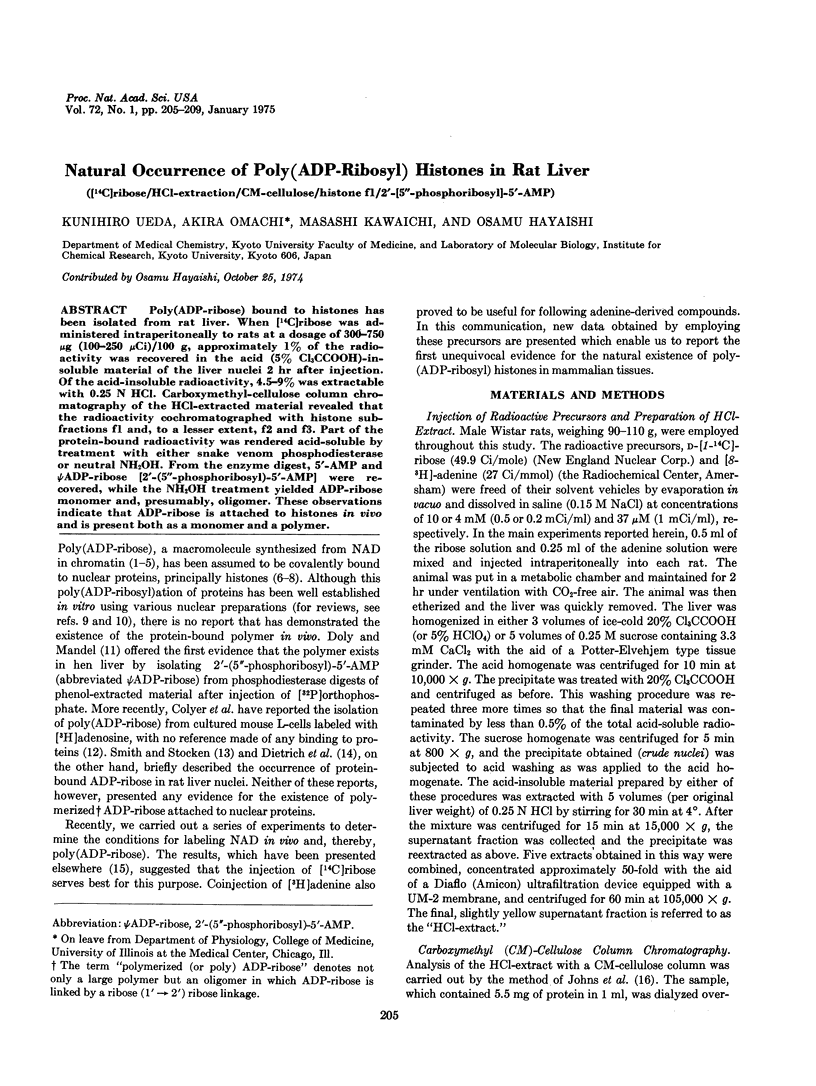Abstract
Poly(ADP-ribose) bound to histones has been isolated from rat liver. When [14C]ribose was administered intraperitoneally to rats at a dosage of 300-750 mug (100-250 muCi)/10o g, approximately 1% of the radioactivity was recovered in the acid (5% CLCCCOOH)-INSOLUBLE MATERIAL OF THE LIVER NUCLEI 2 HR AFTER INJECTION. Of the acid-insoluble radioactivity, 4.5-9% was extractable with 0.25 N HCL. Carboxymethyl-cellulose column chromatography of the HCl-extracted material revealed that the radioactivity cochromatographed with histone subfractions f1 and, to a lesser extent, f2 and f3. Part of the protein-bound radioactivity was rendered acid-soluble by treatment with either snake venom phosphodiesterase or neutral NH2OH. From the enzyme digest, 5'-AMP and psiADP-ribose [2'-(5"-phosphoribosyl)-5'-AMP] were recovered, while the NH2OH treatment yielded ADP-ribose monomer and, presumably, oligomer. These observations indicate that ADP-ribose is attached to histones in vivo and is present both as a monomer and a polymer.
Full text
PDF




Selected References
These references are in PubMed. This may not be the complete list of references from this article.
- Colyer R. A., Burdette K. E., Kidwell W. R. Poly ADP-ribose synthesis and DNA replication in synchronized mouse L-cells. Biochem Biophys Res Commun. 1973 Aug 6;53(3):960–966. doi: 10.1016/0006-291x(73)90185-x. [DOI] [PubMed] [Google Scholar]
- Dietrich L. S., Jaus H., Siebert G. In vivo occurence of bound ADP-ribose. FEBS Lett. 1973 Dec 1;37(2):228–230. doi: 10.1016/0014-5793(73)80465-x. [DOI] [PubMed] [Google Scholar]
- Doly J., Mandel P. Mise en évidence de la biosynthèse in vivo d'un polymère composé, le polyadénosine diphosphoribose dans les noyaux de foie de poulet. C R Acad Sci Hebd Seances Acad Sci D. 1967 Jun 5;264(23):2687–2690. [PubMed] [Google Scholar]
- JOHNS E. W., PHILLIPS D. M., SIMSON P., BUTLER J. A. Improved fractionations of arginine-rich histones from calf thymus. Biochem J. 1960 Dec;77:631–636. doi: 10.1042/bj0770631. [DOI] [PMC free article] [PubMed] [Google Scholar]
- LUCK J. M., RASMUSSEN P. S., SATAKE K., TSVETIKOV A. N. Further studies on the fractionation of calf thymus histone. J Biol Chem. 1958 Dec;233(6):1407–1414. [PubMed] [Google Scholar]
- Nishizuka Y., Ueda K., Honjo T., Hayaishi O. Enzymic adenosine diphosphate ribosylation of histone and poly adenosine diphosphate ribose synthesis in rat liver nuclei. J Biol Chem. 1968 Jul 10;243(13):3765–3767. [PubMed] [Google Scholar]
- Nishizuka Y., Ueda K., Nakazawa K., Hayaishi O. Studies on the polymer of adenosine diphosphate ribose. I. Enzymic formation from nicotinamide adenine dinuclotide in mammalian nuclei. J Biol Chem. 1967 Jul 10;242(13):3164–3171. [PubMed] [Google Scholar]
- Nishizuka Y., Ueda K., Yoshihara K., Yamamura H., Takeda M., Hayaishi O. Enzymic adenosine diphosphoribosylation of nuclear proteins. Cold Spring Harb Symp Quant Biol. 1969;34:781–786. doi: 10.1101/sqb.1969.034.01.088. [DOI] [PubMed] [Google Scholar]
- Ord M. G., Stocken L. A. Metabolic properties of histones from rat liver and thymus gland. Biochem J. 1966 Mar;98(3):888–897. doi: 10.1042/bj0980888. [DOI] [PMC free article] [PubMed] [Google Scholar]
- Otake H., Miwa M., Fujimura S., Sugimura T. Binding of ADP-ribose polymer with histone. J Biochem. 1969 Jan;65(1):145–146. [PubMed] [Google Scholar]
- Reeder R. H., Ueda K., Honjo T., Nishizuka Y., Hayaishi O. Studies on the polymer of adenosine diphosphate ribose. II. Characterization of the polymer. J Biol Chem. 1967 Jul 10;242(13):3172–3179. [PubMed] [Google Scholar]
- Römer V., Lambrecht J., Kittler M., Hilz H. Identity of nuclear NAD nucleosidase with a polyADP-ribose forming enzyme in Ehrlich ascites tumor cells. Hoppe Seylers Z Physiol Chem. 1968 Jan;349(1):109–112. [PubMed] [Google Scholar]
- SHUSTER L., GOLDIN A. The incorporation of C14-glucose and C14-ribose into mouse liver diphosphopyridine nucleotide. J Biol Chem. 1958 Feb;230(2):873–881. [PubMed] [Google Scholar]
- Shima T., Hasegawa S., Fujimura S., Matsubara H., Sugimura T. Studies on poly adenosine diphosphate-ribose. VII. Methods of separation and identification of 2'-(5"-phosphoribosyl)-5'-adenosine monophosphate, ribosyladenosine monophosphate, and phosphoribosyladenosine. J Biol Chem. 1969 Dec 25;244(24):6632–6635. [PubMed] [Google Scholar]
- Smith J. A., Stocken L. A. Identification of poly (ADP-ribose) covalently bound to histone F1 in vivo. Biochem Biophys Res Commun. 1973 Sep 5;54(1):297–300. doi: 10.1016/0006-291x(73)90922-4. [DOI] [PubMed] [Google Scholar]
- Sugimura T., Fujimura S., Hasegawa S., Kawamura Y. Polymerization of the adenosine 5'-diphosphate ribose moiety of NAD by rat liver nuclear enzyme. Biochim Biophys Acta. 1967 Apr 18;138(2):438–441. doi: 10.1016/0005-2787(67)90507-2. [DOI] [PubMed] [Google Scholar]
- Ueda K., Reeder R. H., Honjo T., Nishizuka Y., Hayaishi O. Poly adenosine diphosphate ribose synthesis associated with chromatin. Biochem Biophys Res Commun. 1968 May 10;31(3):379–385. doi: 10.1016/0006-291x(68)90486-5. [DOI] [PubMed] [Google Scholar]


